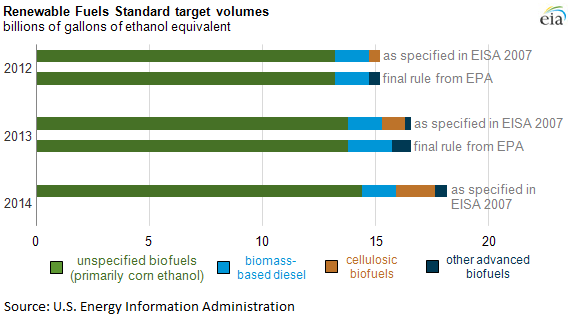 In the wake of the Environmental Protection Agency (EPA) issuing its final rule for the 2013 Renewable Fuel Standard (RFS), the government revised down targets for cellulosic biofuel use this year. The U.S. Energy Information Administration reports the new rule sets a 6 million gallon target for cellulosic biofuels use in 2013, less than half what was proposed just six months ago… and well below the 1 billion gallon target specified in the Energy Independence and Security Act of 2007:
In the wake of the Environmental Protection Agency (EPA) issuing its final rule for the 2013 Renewable Fuel Standard (RFS), the government revised down targets for cellulosic biofuel use this year. The U.S. Energy Information Administration reports the new rule sets a 6 million gallon target for cellulosic biofuels use in 2013, less than half what was proposed just six months ago… and well below the 1 billion gallon target specified in the Energy Independence and Security Act of 2007:
By law, EPA can lower the required volumes of advanced biofuels and total renewable fuels by up to the amount that it reduces the required volume of cellulosic biofuels. EPA chose not to reduce the advanced biofuels and total renewable fuels targets for 2013, leaving the required volume of total renewable fuels in 2013 at the 16.55 billion gallons specified in EISA 2007. However, the final rule states that EPA anticipates the need to adjust those targets for the 2014 RFS program year, for which EISA 2007 specifies a total renewable fuels target of 18.15 billion gallons. EPA’s forthcoming notice of proposed rulemaking for the 2014 RFS program year will provide further information.
As discussed in previous TIE articles, a May 2013 letter from EIA cited in EPA’s final RFS rule, and recent testimony by EIA Administrator Adam Sieminski, production of cellulosic biofuels has grown at a much slower pace than envisioned in EISA 2007. The RFS consists of four nested volumetric targets for specific types of biofuels. By 2022, EISA 2007 specifies a 36 billion gallon target for total renewable fuels in transportation fuel, including 21 billion gallons of advanced biofuels, of which 16 billion gallons are cellulosic biofuels.

The EIA goes on to say that some parts of the RFS have been hard to implement because of lower-than-anticipated gasoline consumption, as well as issues with the E10 blend wall and using higher blends in current vehicles and infrastructure.












